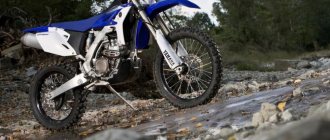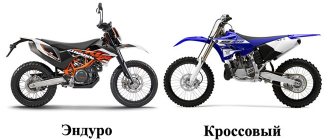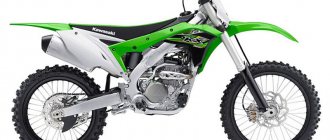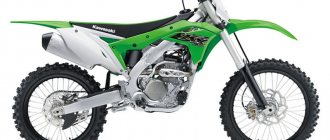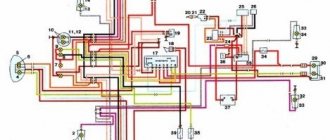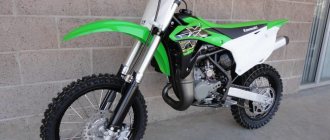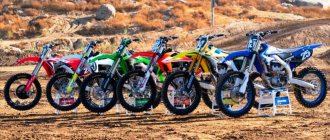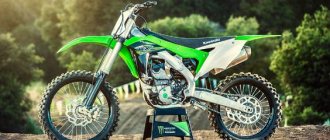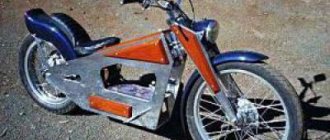The Suzuki RM 250 cross-country motorcycle was presented to the general public in the distant 1976. 5 years later, in the early 1980s, the bike received a modern appearance. This was the only change to the motorcycle in its entire history. Production continued until 2008, but already in 2004 the developer releases an updated version - Suzuki RM-Z250.
Despite its rather respectable age and 2T (two-stroke) engine, the bike had serious advantages - a simple suspension, but with all the adjustment capabilities , a 5-speed transmission and less than 100 kg of dry weight .
Initially it was planned only for North American countries, but seeing the interest of users in 1989, deliveries began around the world.
It was not officially offered to Russia, but was available through “gray” sales. Since the model is no longer produced, the motorcycle can only be purchased on the secondary market.
Brief history of the model
2002 - launch of the Suzuki RM-Z 250. During this period, the model is an exact copy of the Kawasaki KX 250 F.
2003 - 2009 - the motorcycle remained virtually unchanged technically. Only the ergonomics and precision of motorcycle control changed.
2010 - Suzuki seriously updates its Suzuki RM-Z 250. It is a completely new motorcycle with fuel injection and a redesigned chassis. Almost every component of the motorcycle has undergone changes - this includes a new aluminum frame, more advanced cooling radiators, and new adjustable suspensions. In addition, the Suzuki RM-Z 250 no longer had a battery, and the 16-bit engine control unit was powered by an internal capacitor.
2011 - The motorcycle oil pump was moved to the bottom of the crankcase, changes to the engine affected the cylinder shape and camshaft profile. Thanks to changes in the engine, the motorcycle began to produce power characteristics at the level of market leaders.
Modifications and competitors
Honda CR250R.
Kawasaki KX 250.
Yamaha YZ 250.
With the same steel frame, the bike has only one competitor - the Kawasaki KX 250.
Other manufacturers of the Japanese four made equivalent motocross versions based on aluminum frames.
- For Honda it's the CR250R.
- For Yamaha - YZ 250.
Specifications
| Model: | Suzuki RM-Z 250 |
| Type: | Cross |
| Year of issue: | 2014 |
| Engine's type: | 1 - cylinder, 4 - stroke |
| Working volume: | 249 cc cm. |
| Cooling: | Liquid |
| Bore and stroke: | 77 x 53.6 mm |
| Compression ratio: | 13,5:1 |
| Number of valves per cylinder: | 4 |
| Fuel supply system: | Electronic injection (injector) |
| Ignition type: | Electronic |
| Maximum power: | 43.7 hp at 11800 rpm. |
| Maximum torque: | 30.1 Nm at 8500 rpm. |
| Transmission: | 5-speed |
| Type of drive: | Chain |
| Frame: | Diagonal, aluminum |
| Front suspension: | Inverted adjustable fork, 310 mm travel |
| Rear suspension: | Monoshock absorber with progression (adjustable), stroke - 310 mm |
| Front tire size: | 80/100-21 |
| Rear tire size: | 100/90-19 |
| Front brake: | One 250 mm disc, 2 piston calipers |
| Rear brake: | One 240 mm disc, 1 piston caliper |
| Dimensions: | 2170 x 830 x 1270 mm |
| Seat height: | 955 mm |
| Wheelbase: | 1475 mm |
| Gas tank volume: | 6.5 l. |
| Curb weight: | 104.5 kg. |
Driving performance
The maximum speed indicated in the documentation for the motorcycle was 160 km/h . But the owners say that when the mark is reached, there is a reserve of power for another 20–40 km .
Users note crazy acceleration dynamics, but if you look at the specifications - from 0 to 100 in 8.5 seconds .
Fuel consumption
The consumption is quite high - from 4 liters for off-road use, but considering that the motorcycle is designed only for circuit competitions - it can be called normal. Having a tank of 8 liters , the bike can travel almost 200 km on one fill.
If you consider that this is a sports equipment, and according to traffic rules it should not appear on public roads, then the indicator is more than good .
Advantages and disadvantages
Advantages:
Not the most powerful engine in the class, but 100% suitable for racing.
Takes turns better than anyone in the class.
Not the best brakes, but they are completely sufficient.
Not the lightest, but not the heaviest motocross bike in the class.
Flaws:
Clutch too soft.
Slurred operation of the box under heavy loads (when switching from 2nd to 3rd gear).
High quality grips, but very difficult to change.
Stock tires are not suitable for racing.
Peculiarities
The bike has many distinctive features:
- the main one, of course, was oil consumption, which needed to be added every time the motorcycle was refueled;
- power was noted, giving good dynamics;
- traction at any speed;
- adjustable suspension;
- some “ weakness ” of the front brake, which grabbed well only when you pressed the handle all the way;
- lack of a central stand.
But controllability and maneuverability were also noted.
Advanced electronic systems of the Suzuki motocross motorcycle
Fuel chips and traction control
Fuel chips help you easily set up the injection system. The RM-Z250 motocross motorcycle is equipped with two fuel chips for quick adjustment of the fuel system. The first feature is designed for strong fuel delivery, the second for limited fuel supply compared to stock settings. Pilots can independently change the fuel supply by simply connecting the necessary feature. The 2021 Suzuki RMZ 250 comes with an advanced and responsive traction control system. The Electronic Control Module (ECM) constantly measures how open the throttle valve is, engine speed and position, and adjusts ignition timing and fuel spray accordingly. The traction control system of the motocross Suzuki RMZ 250 differs from the traction control system of city motorcycles because it does not measure the rotation speed of the rear wheel. The reason is that a motocross motorcycle has a completely different purpose compared to a city motorcycle. This system constantly changes settings so that the motorcycle's grip on the road is maximum at any time.
Launch control system
Suzuki Holeshot Assist Control (S-HAC) is a special launch control system borrowed from factory motorcycles. It helps pilots gain an advantage at the start. The S-HAC system has three levels of assistance:
- moment of initial start,
- while crossing the starting gate,
- while accelerating to maximum speed.
The pilot can choose one of three modes that best suits his driving style and launch conditions. Modes A and B have been improved to allow the pilot to better control engine speed during takeoff. Mode A is suitable for hard surfaces or slippery conditions. In this mode, S-HAC changes the ignition timing at the moment of start, reducing the likelihood of wheel slip. This mode also optimizes ignition timing during active acceleration. After 6 seconds or upon reaching fourth gear, the system automatically turns off and returns to normal ignition timing.
Advantages of mode-A: great for novice pilots and for starting on slippery roads.
Mode-B is used when there is better grip at the start and you want to take off more aggressively. S-HAC increases ignition timing to speed up throttle response. Changing the ignition phases follows the same principle as in mode-A. After 6 seconds or upon reaching fourth gear, the system automatically turns off and returns to normal ignition timing.
Advantages of Mode-B: Suitable for experienced pilots and for starting in favorable conditions. Mode-B is more suitable for aggressive starts.
Basic mode: standard starting mode that does not require S-HAC operation.
Change your steering wheel!
At first glance, our testers weren't too fond of the RM-Z. A stationary motorcycle immediately had negative aspects, such as a hard saddle with a peculiar slope and a handlebar that was too bent and low, which negatively affected the piloting position. The higher the saddle rises, the more the hands turn out. The ergonomics of the motorcycle, adjusted to Carmichael, did not cause unanimous enthusiastic reviews. Further, from the first laps on the track, the “oakiness” of the motorcycle comes to the fore. Too oaky in feel, the Suzuki is the most difficult to control compared to other motorcycles. To such an extent that it begs comparison with its older sister, the 450cc model. Comparison in terms of the severity of the shift on winding sections and the slowness of the response. Probably similar motorcycle settings are suitable for such aliens as Carmichael, but our test pilots would definitely go faster with a classic steering wheel and softer settings. Plus, as we already mentioned, close gear ratios force the gearbox to work a lot as soon as cornering speeds increase (it’s not possible to do everything in one gear, like on a Honda), and taking into account the inconvenience of piloting, the Susa ranks last in terms of efficiency on the track (stock motorcycle). But it costs the least! Here, as they say, it’s either one or the other. You can invest the difference in price into customizing the motorcycle, and the result will probably be better.
Suzuki rmz 250 chassis characteristics
Chassis functional characteristics: in 2019, the Suzuki RMZ 250 received a new frame and a new swingarm design. They reaffirmed Suzuki's reputation for producing the best handling motorcycles. The new bias-ply frame combines cast and extruded elements to achieve the optimal weight balance of a motocross bike. The new frame is 370g lighter, but 10% stronger in torsion. The engine in the new frame received a new location, so the crankshaft was higher. The rear and top engine mounting points have been modified. Instead of steel, the engine mounts are now made of aluminum to reduce weight. The new swingarm was produced through a hydroforming process, resulting in a very strong yet lightweight swingarm, 270g lighter than the previous one. The subframe mounts have been moved back to give the bike a sleeker look, and they've also been raised slightly to accommodate a larger air cleaner. Engineers not only narrowed the subframe, the plastic overall became neater so that the rider could move freely in the saddle while riding.
Suzuki RM-Z 250: first race
Don’t look for a cheaper motocross bike among Japanese motocross bikes.. With a price that is several hundred euros lower than its competitors, the RM-Z 2009 has something to puzzle cross-slingers in terms of the agony of choice at the threshold of a motorcycle store.. And indeed, upon a meticulous inspection motorcycle, Suza doesn’t have to blush. Among the first reviews from our pilots, the following can be noted: “the workmanship is rather good, even though it has nothing special to brag about,” “the problem with Japanese motorcycles is that they are all similar to each other, except for the color.” Noted and an attempt to embellish the motorcycle with Renthal handlebars and Excel rims.. But it’s true, it will be very difficult for an inexperienced person (especially a colorblind person) to distinguish one of these motorcycles from another outwardly... Thank God, once you get on the motorcycle and go to the track, there’s a difference among this group of cross-shoes it becomes obvious!
